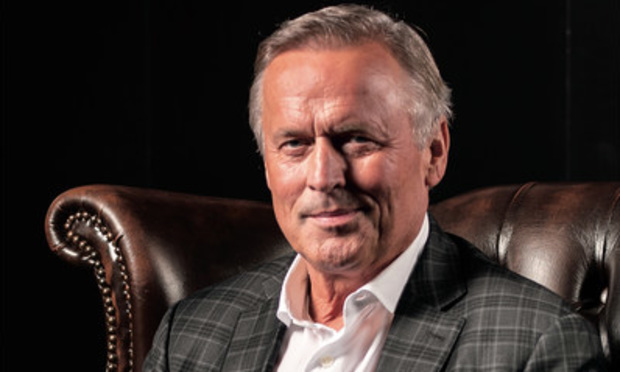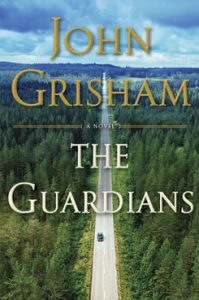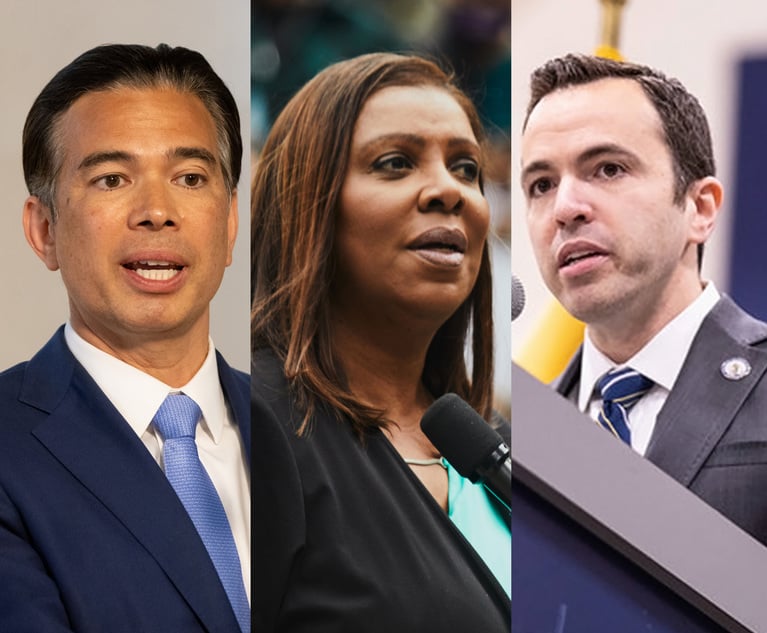A Conversation With John Grisham: 'In Popular Fiction, You Better Stay Off the Soapbox.'
In his just-released book, Grisham tackles the subject of wrongful convictions. He has a lot to say about the criminal justice system's flaws. But facing a socially charged topic, he was careful how he went about it.
October 30, 2019 at 11:59 AM
8 minute read
 John Grisham. (Photo: Charlotte Graham)
John Grisham. (Photo: Charlotte Graham)
Duke Russell has spent nine years on Alabama's death row. He came within an hour of being executed. An appeals court granted a stay while he was eating his last meal. Russell maintains his innocence and has fought strenuously to be exonerated.
Quincy Miller has been behind bars in Florida for 22 years for murder. One holdout juror spared him from the death penalty. Miller also claims his innocence and has battled for his freedom.
These are harrowing tales. But neither is real. They come from best-selling author John Grisham and exist on the pages of "The Guardians," his latest work of fiction.
In this just-released title, currently No. 1 on The New York Times bestseller list for fiction, Grisham, 64, tackles the subject of wrongful convictions. He has a lot to say about how the system got the wrong guys in these cases. But facing a socially charged topic, he was careful how he went about it.
"In popular fiction you better stay off the soapbox," Grisham tells me over breakfast at a Midtown Manhattan hotel. "That's not my role."
Seeking to undo Russell and Miller's miscarriages is their lawyer, Cullen Post, a burned-out former public defender turned priest now working for a hardscrabble nonprofit law firm, who travels the country seeking to exonerate those wrongfully behind bars. In "Post," Grisham pays tribute to Jim McCloskey, a priest and near 40-year veteran of the innocence movement, whose work has led to 63 men and woman being exonerated for crimes that they did not commit.
 In "The Guardians," Grisham explores why the innocent are sometimes found guilty, such as by planted evidence, fabricated testimony and jailhouse snitches. He places particularly sharp focus on prosecutors' use of scientific evidence with dubious reliability.
In "The Guardians," Grisham explores why the innocent are sometimes found guilty, such as by planted evidence, fabricated testimony and jailhouse snitches. He places particularly sharp focus on prosecutors' use of scientific evidence with dubious reliability.
But to stay off the soapbox, Grisham tells me that he lets "the story make the points." In doing so, he finds inspiration in cases that have troubled him.
For Miller, his fate was sealed by a flashlight found in the trunk of his car, containing tiny specs of blood on the lens. Miller's story comes from the real-life case of Joe Bryan, who has been behind bars in Texas for 30 years for murdering his wife. Like Miller, the strongest evidence linking Bryan to his crime was a blood-specked flashlight discovered in the trunk of his car.
In both cases, prosecutors used purported experts in bloodstain-pattern analysis to testify that the blood was indicative of a close-range shooting. However, the experts had virtually no training on the subject. Grisham calls the expert's testimony in Bryan's case "overreaching, speculative and not based on science."
Last year, the Texas Forensic Science Commission—created by the Texas Legislature—concluded that the blood-spatter analysis used to convict Bryan was "not accurate or scientifically supported." The commission also concluded that the expert who testified against Bryan was "entirely wrong." That expert has himself stated in an affidavit that his conclusions were wrong.
Grisham's character Duke Russell landed on death row after a purported expert in bite mark analysis testified that Russell's teeth were the source of three nicks on the arm of his victim. Grisham found inspiration in the Mississippi case of Kennedy Brewer, a man sentenced to death for rape and murder. Brewer was convicted based on bite mark evidence and then exonerated—after seven years on death row—when the real killer was identified through DNA.
According to the National Academy of Sciences looking at the subject, in numerous instances experts, have disagreed in their evaluations of the same bite marks. Cases abound of individuals convicted based on bite-mark evidence and later proven innocent through DNA.
Character Quincy Miller also owes his conviction to a jailhouse informant, which Grisham calls "a huge problem" leading to wrongful convictions. He describes a practice of the police giving another prisoner, looking for leniency for himself, the facts of the crime and putting him in a cell with the suspect. "And sure enough," Grisham explains, "two days later, the snitch pops out and says, 'Oh, he bragged about killing his wife. He beat her to death with a claw hammer.'"
This tactic works, Grisham says, because "jurors cannot believe that a guy will clean up, coat and tie, hide his tattoos" and then "swear to tell the truth and just tell a total fictional story. They can't believe that. And so they believe him."
In 2018, The Innocence Project, a nonprofit organization working to exonerate the wrongfully convicted—Grisham serves on the board—secured freedom for nine individuals, the most in the organization's 26-year history. They are very difficult cases to win, Grisham says, because "they fight you."
He points to the case of Karl Fontenot, who was convicted of murder in Oklahoma in 1985 and is serving life in prison. In late August, an Oklahoma federal court in a 190-page opinion concluded that Fontenot established the "actual innocence" necessary to pave the way for his release from prison. But the state of Oklahoma appealed the judge's decision to the federal court of appeals. "That'll burn another year or two," Grisham says, in disbelief. "He's been there 35 years. They're trying to get him out, but it's so frustrating."
Despite these challenges, Grisham says that, because of recent exonerations by DNA evidence, sometimes "a judge will ask the prosecutor, 'Why are you afraid of DNA testing? Why are you fighting DNA testing?'"
Grisham lays the blame for some wrongful convictions at the feet of corrupt prosecutors. He rails against a system that he says does not hold them accountable. He saw hope last year after New York created an 11-member Commission on Prosecutorial Misconduct to investigate the conduct, qualifications and fitness of prosecutors.
But the law has yet to go into effect. It is being challenged in court by various New York district attorneys on all manner of arguments based on constitutional infirmities.
Grisham shows his emotion when discussing the stalled law. "You know, it's so frustrating when you watch some of these prosecutors and the way they cover up their mistakes," he says. "New York had the guts to at least pass the law. Nobody else has done that." He adds, "Why do prosecutors fight something that's good law? They have this mentality to fight every effort that we make to hold them accountable."
Grisham says he has often wondered what would happen if it were conclusively established that an innocent person had been executed. He tackled this question in his 2010 thriller "The Confession." But he may soon get an answer in real life. In October, a Tennessee court heard arguments from April Alley, seeking to have DNA from a crime scene tested in an attempt to prove the innocence of her father, Sedley Alley, who was executed in 2006 for rape and murder.
Grisham thinks he knows the answer: "If they prove they killed the wrong guy, they're not going to change their laws. They're not going to abolish the death penalty."
The subject of wrongful convictions is not a new one for Grisham. In 2004, he saw an obituary for Ronald Keith Williamson, who had died in Oklahoma. It included a picture of Williamson, five years earlier, being released from prison, after DNA evidence cleared him of murder. Grisham says he asked himself "how is a white guy, my age, in Oklahoma on death row, who came within five days of being executed, completely innocent?" He also learned that Williamson was a second round draft pick of the Oakland A's in 1971.
"It was a great story," Grisham tells me. "I'm always drawn to stories." This led to him getting into the subject "big time." Two years later he published "The Innocent Man," his only work of nonfiction, in which he tells of Williamson's saga. "It's become a 15-year journey now."
As an author drawn to stories, Grisham is in fertile territory with his interest in wrongful convictions. Stories are what "drive the entire innocence movement," he tells me, "because the stories are so real and so loaded with human suffering."
Randy Maniloff is an attorney at White and Williams in Philadelphia and an adjunct professor at Temple University Beasley School of Law.
This content has been archived. It is available through our partners, LexisNexis® and Bloomberg Law.
To view this content, please continue to their sites.
Not a Lexis Subscriber?
Subscribe Now
Not a Bloomberg Law Subscriber?
Subscribe Now
NOT FOR REPRINT
© 2025 ALM Global, LLC, All Rights Reserved. Request academic re-use from www.copyright.com. All other uses, submit a request to [email protected]. For more information visit Asset & Logo Licensing.
You Might Like
View All
Federal Judge Pauses Trump Funding Freeze as Democratic AGs Plan Suit
4 minute read
Former U.S. Dept. of Education Attorney Suspended for Failure to Complete CLE Credits
3 minute read

4th Circuit Upholds Virginia Law Restricting Online Court Records Access
3 minute readTrending Stories
- 1Stevens & Lee Hires Ex-Middle District of Pennsylvania U.S. Attorney as White-Collar Co-Chair
- 2Alameda Judge Ursula Jones Dickson Chosen as District Attorney
- 3'A Long 6 Years': No $150M for Goldman Sachs Investors
- 4Ex-Appellate Court Judges Launch Boutique Focused on Plaintiffs Appeals
- 5Judge Tanks Prevailing Pittsburgh Attorneys' $2.45M Fee Request to $250K
Who Got The Work
J. Brugh Lower of Gibbons has entered an appearance for industrial equipment supplier Devco Corporation in a pending trademark infringement lawsuit. The suit, accusing the defendant of selling knock-off Graco products, was filed Dec. 18 in New Jersey District Court by Rivkin Radler on behalf of Graco Inc. and Graco Minnesota. The case, assigned to U.S. District Judge Zahid N. Quraishi, is 3:24-cv-11294, Graco Inc. et al v. Devco Corporation.
Who Got The Work
Rebecca Maller-Stein and Kent A. Yalowitz of Arnold & Porter Kaye Scholer have entered their appearances for Hanaco Venture Capital and its executives, Lior Prosor and David Frankel, in a pending securities lawsuit. The action, filed on Dec. 24 in New York Southern District Court by Zell, Aron & Co. on behalf of Goldeneye Advisors, accuses the defendants of negligently and fraudulently managing the plaintiff's $1 million investment. The case, assigned to U.S. District Judge Vernon S. Broderick, is 1:24-cv-09918, Goldeneye Advisors, LLC v. Hanaco Venture Capital, Ltd. et al.
Who Got The Work
Attorneys from A&O Shearman has stepped in as defense counsel for Toronto-Dominion Bank and other defendants in a pending securities class action. The suit, filed Dec. 11 in New York Southern District Court by Bleichmar Fonti & Auld, accuses the defendants of concealing the bank's 'pervasive' deficiencies in regards to its compliance with the Bank Secrecy Act and the quality of its anti-money laundering controls. The case, assigned to U.S. District Judge Arun Subramanian, is 1:24-cv-09445, Gonzalez v. The Toronto-Dominion Bank et al.
Who Got The Work
Crown Castle International, a Pennsylvania company providing shared communications infrastructure, has turned to Luke D. Wolf of Gordon Rees Scully Mansukhani to fend off a pending breach-of-contract lawsuit. The court action, filed Nov. 25 in Michigan Eastern District Court by Hooper Hathaway PC on behalf of The Town Residences LLC, accuses Crown Castle of failing to transfer approximately $30,000 in utility payments from T-Mobile in breach of a roof-top lease and assignment agreement. The case, assigned to U.S. District Judge Susan K. Declercq, is 2:24-cv-13131, The Town Residences LLC v. T-Mobile US, Inc. et al.
Who Got The Work
Wilfred P. Coronato and Daniel M. Schwartz of McCarter & English have stepped in as defense counsel to Electrolux Home Products Inc. in a pending product liability lawsuit. The court action, filed Nov. 26 in New York Eastern District Court by Poulos Lopiccolo PC and Nagel Rice LLP on behalf of David Stern, alleges that the defendant's refrigerators’ drawers and shelving repeatedly break and fall apart within months after purchase. The case, assigned to U.S. District Judge Joan M. Azrack, is 2:24-cv-08204, Stern v. Electrolux Home Products, Inc.
Featured Firms
Law Offices of Gary Martin Hays & Associates, P.C.
(470) 294-1674
Law Offices of Mark E. Salomone
(857) 444-6468
Smith & Hassler
(713) 739-1250








